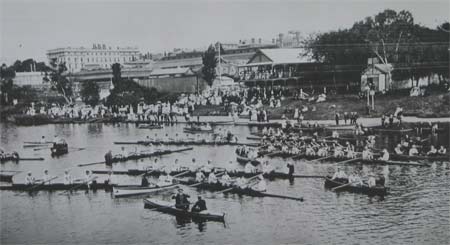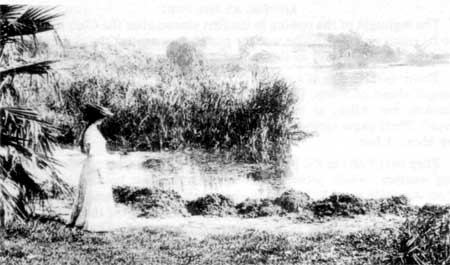Adelaide Rowing Club - The First Hundred Years
A Narrative History 1882-1982 - Compiled by R W Richardson
Table of Contents
Chapters
- Introduction
- I Zingari: The Origin of the Club
- Narrative History of ARC: 1882-1887
- 1887-1892
- 1892-1897
- 1897-1902
- 1902-1907
- 1907-1912
- 1912-1922
- 1922-1927
- 1927-1932
- 1932-1937
- 1937-1942
- 1942-1947
- 1947-1952
- 1952-1957
- 1957-1962
- 1962-1967
- 1967-1972
- 1972-1977
- 1977-1982
- Early Days of Rowing on the Murray
- Memoirs of my Association with the ARC and Rowing Men
- ARC's Famous Coxswains Over the Years
- Get Fit for Autumn—How to do it
- Notable ARC Coaches
- ARC at War
- Pity the Poor Hon. Secretary!
Appendices
4. Narrative History of the Adelaide Rowing Club - 1887-1892
The Opening of the New Boatshed
On Saturday, the 14th December, 1889, the new boatshed was opened by the Countess of Kintore. The function is reported as follows: -
"About 3 o'clock the Countess of Kintore arrived, being met by the President of the Club (Mr. Caleb Peacock), the Speaker of the House of Assembly (Hon. J.C. Bray), the Mayor of Adelaide (Mr. L. Cohen, M.P.), Mr. J. Milne (Captain of the Club), and several other gentlemen, who escorted her to the shed, the passage being lined by members forming an avenue with their oars. Mr. Peacock, on behalf of the Club, then thanked Lady Kintore for her attendance, and handing her the keys of the boatshed requested her to declare it open, which she did amid cheers. The company then entered the shed, where an inspection was made, the praise being universal in regard to the completeness of the arrangements.
"The boats were then carried down to the stage, when a handsome oaken mallet was presented to Lady Kintore, with which she smashed a bottle of champagne over the boats, and christened them in the following order `I Zingari' (best racing four), `The Torrens' (outrig clinker), `The Thames' (ditto), `The Yarra' (practice clinker), `The Cam" (inrig clinker), ‘The Isis' (ditto), `The Darling' (practice pair), `The Murray' (ditto), and `The Avon' (sculling boat).
"As each boat was named cheers were given by its crew, who immediately went for a spin on the lake, and Messrs. Arthur Wilson and J. Sharp subsequently took Lady Kintore out for a row, Captain Anstruther Thomson, A.D.C., officiating as coxswain. The visitors partook of afternoon tea in a large marquee which was erected by the side of the boatshed."
Thus in one year the Adelaide Rowing Club recovered its former position in rowing circles, after having suffered the total destruction of its shed and boats.
Eight months of the year 1889 were the testing time for the true morale of this young club, and out of adversity came a new strength and a recognition of true friends in the community. Some might say "It was the best thing that could have happened to the Adelaide Rowing Club", but if there had not been "great men contending with adversity" the Club could easily have faded out, like so many clubs have done since that disaster. But there were men like John Milne, the Captain, who still holds the record for the number of consecutive years he remained in that office, twelve years straight.
There was Alf Grayson, that tough, dedicated oarsman and mentor of generations of Adelaide rowers; Joe Sharp and his genius for organising and recording anything from a raffle to the entire South Australian Rowing Association; Fred Poole had already held the fort when things looked black in 1884; Forrester and George Steel were tigers for punishment, and E.C. Clucas was a foundation member who supported the Club for many, many years.
The Adelaide University Boat Club offered the use of their shed and boats. The Adelaide City Corporation, no doubt through the good offices of the Lord Mayor and Alderman Caleb Peacock, the Club's President, offered practical assistance and H.Y. Sparks came forward with £10.10.0 from the S.A. Cricket Association and asked to become a member of the Club. He was destined later to become one of the Club's Presidents.
The Club had a young architect among its members, one J.Q. Bruce who volunteered to produce plans and specifications of a new boathouse for the purpose of calling tenders for consideration of the Committee, and this offer was accepted. This gesture was the beginning of a very successful practice, several members of Adelaide Rowing Club retaining Bruce's services in later years, one of whom was H.R. Dixson, who built that magnificent pile on Montefiore Hill known today as "Carclew" to Bruce's design.
W.P. Auld played a prominent part in raising funds by organizing a concert which contributed £20. W.G. Roberts was another great worker. Remember that not only had the Club to raise money for a new boathouse, but a whole new fleet, and there was no hint of the Club's having had any insurance on the wrecked boathouse or the contents.
All they salvaged was a number of oars, two old skiffs and some building material.
Insurance was taken out on the new boathouse progressively as it was being built, and it was sited well up the river bank on Railways land, above flood level, where it stands today, or rather, where its successor stands today.
Fred Poole it was who negotiated the lease of the land from the Commissioner of Railways, and obtained special rates for the transport of the new boats being built in Melbourne.
The Club's tradition of naming the best racing boat I Zingari and the remainder after prominent rivers was established at the grand Opening of the new boathouse on December 14th, 1889.
With over 500 people present, beautiful weather, a magnificent new boathouse, easily the best fleet of boats in the colony and everything happy and glorious, the Club members must have felt all their suffering and struggle had been worthwhile.

The new boatshed
Season 1889-90, New Boathouse
With everything brand new, the Committee proceeded to get town to rowing again and arranged 3 Club Regattas on consecutive Saturdays for Trial Fours, Double Sculls and the Heseltine Cup, (sculls) the course being an unusual one, namely one mile, starting from the clubhouse, down to the Weir, turn around and back to the Club.
This was brought about mainly by reason of the congested state of the Lake after the great flood, and in part to test the crews' ability to control their boats during the total reversal of direction required, and get away again in short time.
The expert at this in single sculls seems to have been A.J. Grayson, who was the scratch man, the rest varying from 10 to 40 seconds handicap.
Because of the restricted state of the Lake, all rowing was reduced to a maximum width of 2 crews, and when the City Corporation proposed that the Club pay a licence fee on every boat in their fleet, there was quite an outcry for remission of fees until the `river' was made navigable.
After deliberation the fees were commuted to an annual payment £5.0.0 which was still a pretty stiff fee, more than the water rates or the Council rates, indicating that the Corporation regarded all boats on the lake as pleasure craft.
Weeds and Mud
Towards the end of 1891 and into 1892, the state of the Torrens Lake grew even worse. Thousands of tons of silt had settled in the bed of the Lake upstream of the Weir and reduced the usable channel considerably in depth and formed extensive flats on the insides of the bends in the river, where weeds, reeds and other undergrowth encroached further into the channel.

1890-91 - Young lady gazing at the mud and weeds on the Torrens bank.
For 2 years running, 1890 and '91 the S.A.R.A. had to cancel the Summer Regatta for this reason.
The Corporation's answer to the problem was a steam driven sludgepump mounted on a pontoon, which sucked up the liquid mud and deposited it on the banks where it was both an eyesore and proceeded to create a stench, without appearing noticeably to deepen the channel or to clear away the encroaching growth of weeds.
Club Concerts
There wasn't a great deal of enthusiasm for rowing among the more junior, less experienced members, so towards the end of winter, before serious rowing and training had commenced, the Club put on a Concert and invited the Vice Regal party to attend at the Albert Hall on 21st October, 1991. The Countess of Kintore was a great favourite of the Club's and the members really excelled themselves in their efforts to please her and her daughters.
They put on songs, both solos and choruses, a comic act, fancy club swinging, a minstrel-circle, a song-and-dance routine, an overture by Strelitz, a concertina solo, a quartet played "Lovely Night", and to conclude, a one act comedy called "Irish Justice".
It was declared a great success, and helped the Club financially. The participants, besides getting a lot of satisfaction from being in an enterprise that was appreciated, were drawn into closer bonds with each other and to the Club.
